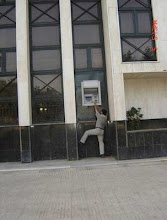Actually, the Congressional Oversight Panel, commissioned to oversee the Wall Street bailout, doesn't know where it went, either.
As a matter of fact, I am predisposed to do this research because the COP Chairwoman, Elizabeth Warren, was a guest on Bill Maher (HBO) 5/15 at which time she stated that COP, and Congress, don't know where the money went.
COP Report 12/08 (Adobe.pdf)
This is the first report of the Congressional Oversight Panel. We
are here to investigate, to analyze and to review the expenditure
of taxpayer funds. But most importantly, we are here to ask the
questions that we believe all Americans have a right to ask: who
got the money, what have they done with it, how has it helped the
country, and how has it helped ordinary people?
In the course of its meetings with Treasury, the Inspector General
of Treasury, and the staff of the Federal Reserve, the Oversight
Panel has confirmed that the Office of Financial Stabilization
has administered the TARP program without seeking to monitor
the use of funds provided to specific financial institutions.49 Interim Assistant Secretary for Financial Stability Neel Kashkari has said that Treasury favors monitoring through ‘‘general metrics’’ that look at the overall economic effects of the disbursed funds.50
Assessing Treasury’s Strategy: Six Months of TARP
The April oversight report for COP is entitled Assessing Treasury’s Strategy: Six Months of TARP. In this report, COP offers a preliminary look at Treasury’s strategy and offers a comparative analysis of previous efforts to combat banking crises in the past.
Over the last six months, Treasury has spent or committed $590.4 billion of the TARP funds. Treasury has also relied heavily on the use of the Federal Reserve’s balance sheet which has expanded by more than $1.5 trillion (not including expected TALF loans) in conjunction with the financial stabilization activities it has undertaken beyond its monetary policy operations. This has allowed Treasury to leverage TARP funds well beyond the funds appropriated by Congress.
The total value of all direct spending, loans and guarantees provided to date in conjunction with the financial stability efforts (including those of the FDIC as well as the Treasury and the Federal Reserve) now exceeds $4 trillion. This report reviews in considerable detail specific criteria for evaluating the impact of these programs on financial markets.
Mortgage Foreclosures / Defaults / Delinquencies.
As measured by foreclosure initiations or completions, either as a rate or absolutely, or by delinquent mortgages, this problem continues to worsen.100
Housing Prices.
Although some of the drop in real estate value reflects a retreat from unsustainable bubble levels, the continued drop in housing prices is a leading contributor to bank asset write downs, recent declines in household net worth, and the weakening broader economy.107
Overall Loan Originations.
In its most recent report, Treasury cited rising consumer lending, especially in mortgages and student loans; however, seasonal changes in student loan demand and increased refinancing demand largely explain this increase.114 Commercial and industrial lending both fell considerably.115 The combination indicates that credit markets remain tight, especially in the business sector.
Mortgage Originations.
A low risk premium coupled with low mortgage volume indicates substantial tightening of lending standards.120 The GAO has indicated a substantial drop in this figure, both as measured by originations and applications, since the first quarter of 2008.
Oh, yes, and what about those "general metrics"?
Indeterminate Metrics (Too Early to Tell)
Some measures of the health of both credit markets and the broader economy are difficult to evaluate as either improving or worsening, either because they are too volatile or because they are contradictory depending on how one examines them.
And, finally, ....
Since October, approximately $280 billion of capital infusions have been made with TARP funds. Nonetheless, losses on impaired assets have continued to weaken the balance sheets of banks and foster uncertainty in the financial markets.
No word about where the money went. (It went OFFSHORE!)
....





No comments:
Post a Comment